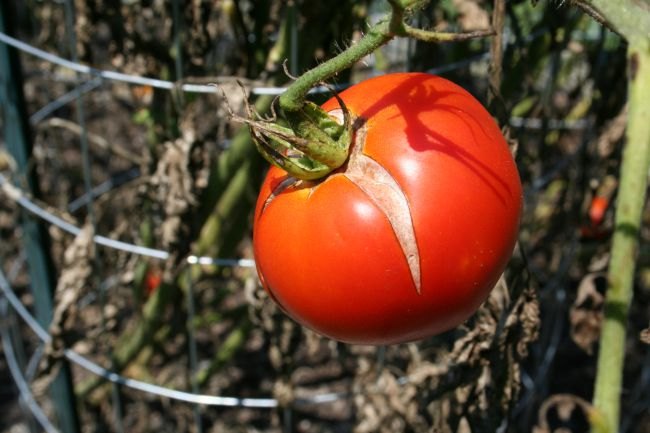Tomato Problems (And How to Fix Them)

by
Jeanne Grunert
(IC: blogger)
Most home gardeners grow tomatoes. Tomatoes grown at home taste so much better than store-bought ones, and tomatoes make excellent container vegetables. You can grow tomatoes almost anywhere; on a sunny deck, patio, balcony, or in the garden. But things can go wrong. Here's how to diagnose some of the most common tomato problems, and how to fix what ails them.
Healthy, ripe tomatoes have a beautiful rich red color and a firm, unblemished skin. The bowl above is filled with Early Girl and Beefsteak tomatoes from my garden.
Vertical cracks such as the one above in this Beefsteak tomato are caused by too much water after a long period of dry weather. In this case, Mother Nature decided to bless us with two inches of water after a week without. Some home gardeners cause this problem by forgetting to water their tomatoes and then watering them too much. As the tomato drinks up the water, the skin on the fruits cannot expand fast enough to accommodate the sudden surge of water, so the skin cracks like a balloon popping when it's filled with too much air. The solution? Steady, even watering (unless nature decides otherwise!)
This tomato not only has cracks but a big, ugly hole where the tomato fruitworm has attacked it. Tomato fruitworms feed on leaves and stems. The larvae tunnel into tomatoes. Once you see signs of fruitworm, check your plants and remove them by hand. Discard fruit that has been eaten, like the one above.
This ugly fellow is the tomato hornworm. Tomato hornworms hide during the day and come out at night. They can easily eat all the leaves off of your plants. They are hard to see. Fortunately, a parasitic wasp saw this one and laid its eggs along the back. The white rice-shaped things on the worm are the larvae. They will eventually kill the tomato hornworm. Natural controls to keep tomato hornworms away are simple. Plant marigolds nearby - the scent keeps the hornworm at bay!
The tomato above has the start of a bacteria disease. It is either anthracnose or bacterial canker, but it is too early to tell. If it develops into anthracnose, the brown spots on the fruit will develop a white halo around them; if none develop, it's a bacteria canker. Regardless, this is a sign that the area in my garden is infected and that I need to rotate my crops next year to avoid planting tomatoes in the same location. Bacterial infections are difficult to eradicate and will eventually kill the plant. Plants showing bacterial disease should be removed from the garden and thrown away rather than composted. Composting diseased plants can introduce bacteria into the compost pile.
I hope that these tips on identifying tomato problems, their causes and solutions is helpful to you. I love growing tomatoes. There's nothing like the fresh taste of ripe tomatoes, or making and canning soup and juice. When you open that can or jar of juice in January, it's like sipping a memory. Happy gardening!
Enjoyed the project?

Want more details about this and other DIY projects? Check out my blog post!
Published August 13th, 2015 12:30 PM
































Frequently asked questions
Have a question about this project?
My tomatoes are more stalks than tomatoes what to do to increase fruit?